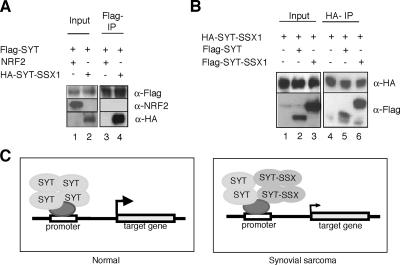FIG. 1.
Dominant-negative function of SYT-SSX1 for forming heterooligomers with SYT. (A) SYT bound SYT-SSX1. FLAG-tagged SYT was transfected with NRF2 (lanes 1 and 3) or HA-tagged SYT-SSX1 (lanes 2 and 4) into HEK293T cells. FLAG-tagged SYT was immunoprecipitated from whole-cell lysates (Inp; left panel) using anti-FLAG antibody-conjugated agarose (FLAG-IP; right panel). Bound proteins were washed and detected with anti-FLAG antibody (SYT), anti-NRF2 antibody (NRF2), or anti-HA antibody (SYT-SSX1). SYT bound SYT-SSX1 but not NRF2. (B) SYT-SSX1 bound SYT-SSX1 itself. HA-tagged SYT-SSX1 was transfected with empty vector (lanes 1 and 4), Flag-tagged SYT (lanes 2 and 5), or Flag-tagged SYT-SSX1 (lanes 3 and 6) into HEK293T cells. HA-tagged SYT-SSX1 was immunoprecipitated from whole-cell lysates (Inp; left panel) using anti-HA antibody-conjugated agarose (HA-IP; right panel). Bound proteins were washed and detected with anti-HA antibody (SYT-SSX1) or anti-Flag antibody (SYT and SYT-SSX1). (C) A model of SYT target gene repression by SYT-SSX. In normal cells, SYT with its homooligomers activates target gene expression. In synovial sarcoma cells, SYT-SSX inhibits the transcriptional activity of SYT by a dominant-negative function by forming heterooligomers with SYT. The gene down-regulation by the dominant-negative function of SYT-SSX1 may lead to synovial sarcoma.

